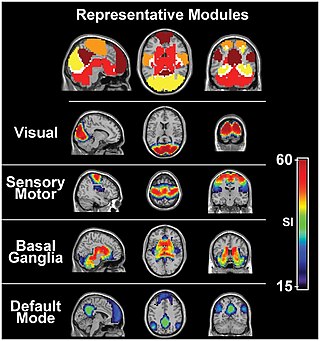
Perception is the organization, identification, and interpretation of sensory information in order to represent and understand the presented information or environment. All perception involves signals that go through the nervous system, which in turn result from physical or chemical stimulation of the sensory system. Vision involves light striking the retina of the eye; smell is mediated by odor molecules; and hearing involves pressure waves.
An illusion is a distortion of the senses, which can reveal how the mind normally organizes and interprets sensory stimulation. Although illusions distort the human perception of reality, they are generally shared by most people.

The sensory nervous system is a part of the nervous system responsible for processing sensory information. A sensory system consists of sensory neurons, neural pathways, and parts of the brain involved in sensory perception and interoception. Commonly recognized sensory systems are those for vision, hearing, touch, taste, smell, balance and visceral sensation. Sense organs are transducers that convert data from the outer physical world to the realm of the mind where people interpret the information, creating their perception of the world around them.

In physiology, a stimulus is a change in a living thing's internal or external environment. This change can be detected by an organism or organ using sensitivity, and leads to a physiological reaction. Sensory receptors can receive stimuli from outside the body, as in touch receptors found in the skin or light receptors in the eye, as well as from inside the body, as in chemoreceptors and mechanoreceptors. When a stimulus is detected by a sensory receptor, it can elicit a reflex via stimulus transduction. An internal stimulus is often the first component of a homeostatic control system. External stimuli are capable of producing systemic responses throughout the body, as in the fight-or-flight response. In order for a stimulus to be detected with high probability, its level of strength must exceed the absolute threshold; if a signal does reach threshold, the information is transmitted to the central nervous system (CNS), where it is integrated and a decision on how to react is made. Although stimuli commonly cause the body to respond, it is the CNS that finally determines whether a signal causes a reaction or not.
Stimulus modality, also called sensory modality, is one aspect of a stimulus or what is perceived after a stimulus. For example, the temperature modality is registered after heat or cold stimulate a receptor. Some sensory modalities include: light, sound, temperature, taste, pressure, and smell. The type and location of the sensory receptor activated by the stimulus plays the primary role in coding the sensation. All sensory modalities work together to heighten stimuli sensation when necessary.

Sensory neurons, also known as afferent neurons, are neurons in the nervous system, that convert a specific type of stimulus, via their receptors, into action potentials or graded receptor potentials. This process is called sensory transduction. The cell bodies of the sensory neurons are located in the dorsal root ganglia of the spinal cord.

A sensorium (/sɛnˈsɔːrɪəm/) is the apparatus of an organism's perception considered as a whole. It is the "seat of sensation" where it experiences, perceives and interprets the environments within which it lives. The term originally entered English from the Late Latin in the mid-17th century, from the stem sens- ("sense"). In earlier use it referred, in a broader sense, to the brain as the mind's organ. In medical, psychological, and physiological discourse it has come to refer to the total character of the unique and changing sensory environments perceived by individuals. These include the sensation, perception, and interpretation of information about the world around us by using faculties of the mind such as senses, phenomenal and psychological perception, cognition, and intelligence.
In neuroscience and psychophysics, an absolute threshold was originally defined as the lowest level of a stimulus – light, sound, touch, etc. – that an organism could detect. Under the influence of signal detection theory, absolute threshold has been redefined as the level at which a stimulus will be detected a specified percentage of the time. The absolute threshold can be influenced by several different factors, such as the subject's motivations and expectations, cognitive processes, and whether the subject is adapted to the stimulus.
Sensory substitution is a change of the characteristics of one sensory modality into stimuli of another sensory modality.
Sensory overload occurs when one or more of the body's senses experiences over-stimulation from the environment.
Neural adaptation or sensory adaptation is a gradual decrease over time in the responsiveness of the sensory system to a constant stimulus. It is usually experienced as a change in the stimulus. For example, if a hand is rested on a table, the table's surface is immediately felt against the skin. Subsequently, however, the sensation of the table surface against the skin gradually diminishes until it is virtually unnoticeable. The sensory neurons that initially respond are no longer stimulated to respond; this is an example of neural adaptation.
In medicine and anatomy, the special senses are the senses that have specialized organs devoted to them:
In psychophysics, sensory threshold is the weakest stimulus that an organism can sense. Unless otherwise indicated, it is usually defined as the weakest stimulus that can be detected half the time, for example, as indicated by a point on a probability curve. Methods have been developed to measure thresholds in any of the senses.
In psychology, a stimulus is any object or event that elicits a sensory or behavioral response in an organism. In this context, a distinction is made between the distal stimulus and the proximal stimulus.

The sense of smell, or olfaction, is the special sense through which smells are perceived. The sense of smell has many functions, including detecting desirable foods, hazards, and pheromones, and plays a role in taste.
Extinction is a neurological disorder that impairs the ability to perceive multiple stimuli of the same type simultaneously. Extinction is usually caused by damage resulting in lesions on one side of the brain. Those who are affected by extinction have a lack of awareness in the contralesional side of space and a loss of exploratory search and other actions normally directed toward that side.
A sense is a biological system used by an organism for sensation, the process of gathering information about the surroundings through the detection of stimuli. Although, in some cultures, five human senses were traditionally identified as such, many more are now recognized. Senses used by non-human organisms are even greater in variety and number. During sensation, sense organs collect various stimuli for transduction, meaning transformation into a form that can be understood by the brain. Sensation and perception are fundamental to nearly every aspect of an organism's cognition, behavior and thought.
Many types of sense loss occur due to a dysfunctional sensation process, whether it be ineffective receptors, nerve damage, or cerebral impairment. Unlike agnosia, these impairments are due to damages prior to the perception process.
Sensory branding is a type of marketing that appeals to all the senses in relation to the brand. It uses the senses to relate with customers on an emotional level. It is believed that the difference between an ordinary product and a captivating product is emotion. When emotion flows in the marketplace, your product shines. When there is no emotion from the product, customers lack the enthusiasm and passion that launches a product to success. Brands can forge emotional associations in the customers' minds by appealing to their senses. A multi-sensory brand experience generates certain beliefs, feelings, thoughts and opinions to create a brandgon image in the consumer's mind.
As long as humans have experienced pain, they have given explanations for its existence and sought soothing agents to dull or cease painful sensations. Archaeologists have uncovered clay tablets dating back as far as 5,000 BC which reference the cultivation and use of the opium poppy to bring joy and cease pain. The Greek writer Homer's The Odyssey, written in 800 BC, features the character of Telemachus using opium to soothe his pain and forget his worries. While some cultures researched analgesics and allowed or encouraged their use, others perceived pain to be a necessary, integral sensation. Physicians of the 19th century used pain as a diagnostic tool, theorizing that a greater amount of personally perceived pain was correlated to a greater internal vitality, and as a treatment in and of itself, inflicting pain on their patients to rid the patient of evil and unbalanced humors.








